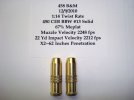expresshunt
AH veteran
After guiding 900 plus Buffalo etc hunts.. the only rifle/cartridge one shot that killed 100% was when the heart was taken out.. or above center through both lungs.. or brain. I'm referring to killed 100%. (not 99 or 95%).. as we all know the 1% is what gets client or ph killed.
So when guiding, most of us want the hunter to only fire when his chosen rifle/gun bullet/arrow will reliably reach and penetrate the above mentioned targets.. then after the first shot,.. personally I ( pre) ask for follow-up shots until it is down. Sorry but I don't do waiting, smokes or such...
My no1 priority is not to be killed at work by a Buffalo etc.. ( or AD)..
Whilst hunters/ clients can try to bring/ invent/ acquire the best (at most any angle/ situation ) cartridges and bullet combos.. that is fine.. I've been there and done that myself.. but now after 28 year.. I long ago learnt its totally about perfect shot placement and damage, then it dies.. I've seen many slightly ill placed 577, 500, 458lott, 458wm bullets from experinced hunters... more so than 375H&H etc... and when I say ill placed I mean the bullet may have slightly missed, even by 1/2" or only taken 1 lung.. or low both lungs.. each looking good, lots of blood etc, but resulting in very live and angry dangerous follow up.
Personally.. Ive read of too many PHs who won't get home ever again.. my friend Glenn G I visited in hospital smashed up very very bad.. almost killed... 2 weeks later I had a confrontation with only binos in hand, 10yds from the 4x4..
So the hunt to me has 2 factors.. 1/ the clients first shot, waiting until the heart/ lung (or brain) can be taken out.. then all will end well... or 2/ we are being charged straight away.. or following up with potential change.. now only 1 thing will 100% kill the Buffalo about to paste you.. a Brain shot.. a solid or well constructed tough expanding bullet... 100% I'm saying.
And if I miss, I need another round placed better.. and if I miss again yet another better aimed and fired shot.
Every day for our hunt season, I go into the the field, my gear must be 100%.. all our rounds must feed.. none can be hot loads and jam.. We must rely on each other, and have a plan.
Yep a 454 Cassul will work at 40yds side on.. yes a 318, 45-70 or 375 or 458GBFKR will work passing through the right spot.
Sorry for the bla bla.. JMO
Back to lever actions.. a guide who knows his 4570 well, is a few rounds better of than an empty double in a battle.
So when guiding, most of us want the hunter to only fire when his chosen rifle/gun bullet/arrow will reliably reach and penetrate the above mentioned targets.. then after the first shot,.. personally I ( pre) ask for follow-up shots until it is down. Sorry but I don't do waiting, smokes or such...
My no1 priority is not to be killed at work by a Buffalo etc.. ( or AD)..
Whilst hunters/ clients can try to bring/ invent/ acquire the best (at most any angle/ situation ) cartridges and bullet combos.. that is fine.. I've been there and done that myself.. but now after 28 year.. I long ago learnt its totally about perfect shot placement and damage, then it dies.. I've seen many slightly ill placed 577, 500, 458lott, 458wm bullets from experinced hunters... more so than 375H&H etc... and when I say ill placed I mean the bullet may have slightly missed, even by 1/2" or only taken 1 lung.. or low both lungs.. each looking good, lots of blood etc, but resulting in very live and angry dangerous follow up.
Personally.. Ive read of too many PHs who won't get home ever again.. my friend Glenn G I visited in hospital smashed up very very bad.. almost killed... 2 weeks later I had a confrontation with only binos in hand, 10yds from the 4x4..
So the hunt to me has 2 factors.. 1/ the clients first shot, waiting until the heart/ lung (or brain) can be taken out.. then all will end well... or 2/ we are being charged straight away.. or following up with potential change.. now only 1 thing will 100% kill the Buffalo about to paste you.. a Brain shot.. a solid or well constructed tough expanding bullet... 100% I'm saying.
And if I miss, I need another round placed better.. and if I miss again yet another better aimed and fired shot.
Every day for our hunt season, I go into the the field, my gear must be 100%.. all our rounds must feed.. none can be hot loads and jam.. We must rely on each other, and have a plan.
Yep a 454 Cassul will work at 40yds side on.. yes a 318, 45-70 or 375 or 458GBFKR will work passing through the right spot.
Sorry for the bla bla.. JMO
Back to lever actions.. a guide who knows his 4570 well, is a few rounds better of than an empty double in a battle.





